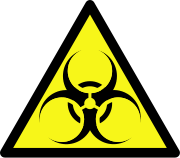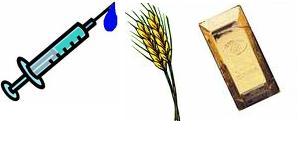|
|
| (41 intermediate revisions not shown) |
| Line 2: |
Line 2: |
| | Content= | | Content= |
| | <div style="font-size:18pt;"> | | <div style="font-size:18pt;"> |
| - | <font face="Arial Rounded MT Bold" style="color:#010369">_ethics</font></div> | + | <font face="Arial Rounded MT Bold" style="color:#010369">_safety</font></div> |
| | <br> | | <br> |
| - | <!--Hallo Moritz, schreib da runter,-->
| |
| - | <br>
| |
| - |
| |
| | <br> | | <br> |
| | + | __NOTOC__ |
| | == Introduction == | | == Introduction == |
| | | | |
| - | The experience, last years iGEM mediated us, clearly shows that students are willing to develop useful applications. They provided medical, environmental or mathematical/computational applications, with no reason to hide themselves from other scientific projects. The fact that students already deal with real scientific projects should expand their sense of responsibility. Normally universities provide basic knowledge and practical skills, but the opportunity to establish own scientific projects is rare. On the one hand enabling students to develop own projects is reasonable, on the other hand a safety problem could occur if this trust is betrayed.<br> | + | The experience, of last years iGEM competition clearly shows that students are willing to develop useful applications. They provided medical, environmental, or mathematical/computational applications, with no reason to hide themselves behind official scientific projects. The fact that students already deal with real scientific projects should expand their sense of responsibility. Normally, universities provide basic knowledge and practical skills, but the opportunity to establish own scientific projects is rare. On the one hand enabling students to develop own projects is reasonable, on the other hand a safety problem could occur if this trust is betrayed.<br> |
| - | Over the past years, progress in science and technology led to totally new possibilities in the field of synthetic biology. New technologies require new discussions, rules and ethical standarts. Therefore it is reasonable to discuss this within the scope of iGEM, in order that students already deal with the safety and responsible handling of their projects. Especially the progress of de novo gene synthesis, sequencing technologies and bioinformatics are the fundamentals for the rapid development of synthetic biology. Creating genes is a powerful tool given into the hand of students, leading to the question: Can they handle it? | + | Over the past years, progress in science and technology led to totally new possibilities in the field of synthetic biology. New technologies require new discussions, rules and ethical standards. Therefore it is reasonable to discuss this within the scope of iGEM, in order that students already deal with the safety and responsible handling of their projects. Especially the progress of de novo gene synthesis, sequencing technologies and bio-informatics are the fundamentals for the rapid development of synthetic biology. Creating genes is a powerful tool given into the hand of students. |
| | <br> | | <br> |
| | | | |
| | == [[Image:180px-Biohazard.svg.png|35px|]] Safety and ethical issues concerning synthetic biology == | | == [[Image:180px-Biohazard.svg.png|35px|]] Safety and ethical issues concerning synthetic biology == |
| | + | |
| | + | Bio-engineers even start to cross the thin line between manipulating life and creating life. Especially, uniqueness of living as part of the human self image confronts with the manipulation and creation of life. Creation of life was only related to god for ages while nowadays education and science change the picture rapidly, leading to a controversial discussion based on a mixture of fear, ignorance, and well grounded critique.<br> |
| | + | In times of unlimited communication and information access, nearly everybody has the possibility to get DNA sequences from pathogenic organisms. It has never before been so easy to create biological weapons, for example viruses. Two experiments have illustrated the possibilities of abuse by the technique of synthetic biology. In 2002, scientists succeeded in rebuilding a Polio Virus by ordering synthetic DNA from commercial companies and assembled the virus in their laboratory. Even more spectacular is an attempt by American scientists in 2005. They successfully reconstructed the genetic information of the flu virus responsible for the highly contagious Spanish flu. The Virus was extinct, but its RNA could be isolated from the tissue of deceased, sequenced and finally the original virus was synthesized. |
| | + | Information on the DNA or RNA of pathogenic organisms may be received from different databases and scientific publications. Synthetic sequences can be ordered from specialized companies, for manageable prices. Finally, these sequences could be assembled to highly effective pathogens. |
| | + | This scenario illustrates how difficult it is to build effective barriers. Because synthetic biology is driven by the simplification of part assemblies it also simplifies abuse. It is undoubtedly important, to control dangerous products of synthetic biology and consistently apply regulations. The case of synthetic biology shows that the problem of technical abuse is not solved by decreasing technical possibilities, but rather that motivations and reasons, to perpetrate abuses, should be understood and eliminated.<br> |
| | + | Also the effects of synthetic organisms on the environment and ecosystems must be considered. For the environment there are risks, when synthetic organisms are introduced into the food chain or when synthetic organisms come into contact with humans for medical purposes. For the environment any use of synthetic life outside the lab means a risk, because a mixture of natural and artificial gene pool can occur. |
| | + | There are projects (e.g. Synbiosafe) concerning the unpredictability of the proliferation from synthetic organisms. Among other things there is an attempt to provide these organisms with a gene for automatic self destruction in case of uncontrolled proliferation.<br> |
| | + | However, creating life means to create something that has the ability to reproduce and mutate itself and therefore gains autonomy. |
| | | | |
| - | == Outlook == | + | == [[Image:M0111111.jpg|80px|]]Outlook == |
| | | | |
| - | == Discussion ==
| + | Considering the fact that about 672.910.000 people are living on earth and the number is rising, mankind will more and more face the circumstance to strike new path. Fast propagating diseases, malnutrition and environmental pollution are great upcoming challenges. Synthetic biology approaches promise to fight some of these problems. Handled with responsibility, there will be endless possibilities (understanding and treatment of diseases, yield increase of plants, bio-fuel generating bacteria and so on). |
| | + | However, to experience the full potential of synthetic biology, security needs to be guaranteed. |
| | | | |
| | + | == [[Image:MO2.jpg|50px|]]References == |
| | | | |
| - | <!--und hier drüber :)--> | + | *Jeronimo Cello, Aniko V. Paul, Eckard Wimmer (2002): Chemical Synthesis of Poliovirus cDNA: Generation of Infectious Virus in the Absence of Natural Template, in Science Vol. 297. no. 5583, pp. 1016 - 1018<br> |
| | + | *Terrence M. Tumpey, Christopher F. Basler, Patricia V. Aguilar, Hui Zeng, Alicia Solórzano, David E. Swayne, Nancy J. Cox, Jacqueline M. Katz, Jeffery K. Taubenberger, Peter Palese, Adolfo García-Sastre (2005):Characterization of the Reconstructed 1918 Spanish Influenza Pandemic Virus, in Science 310 (5745), 77-80 |
| | + | *http://www.synbiosafe.eu/ |
| | }} | | }} |
|
Home
The Team
Project Report
Parts
Modeling
Notebook
Safety
CoLABoration
|
_safety
Introduction
The experience, of last years iGEM competition clearly shows that students are willing to develop useful applications. They provided medical, environmental, or mathematical/computational applications, with no reason to hide themselves behind official scientific projects. The fact that students already deal with real scientific projects should expand their sense of responsibility. Normally, universities provide basic knowledge and practical skills, but the opportunity to establish own scientific projects is rare. On the one hand enabling students to develop own projects is reasonable, on the other hand a safety problem could occur if this trust is betrayed.
Over the past years, progress in science and technology led to totally new possibilities in the field of synthetic biology. New technologies require new discussions, rules and ethical standards. Therefore it is reasonable to discuss this within the scope of iGEM, in order that students already deal with the safety and responsible handling of their projects. Especially the progress of de novo gene synthesis, sequencing technologies and bio-informatics are the fundamentals for the rapid development of synthetic biology. Creating genes is a powerful tool given into the hand of students.
 Safety and ethical issues concerning synthetic biology Safety and ethical issues concerning synthetic biology
Bio-engineers even start to cross the thin line between manipulating life and creating life. Especially, uniqueness of living as part of the human self image confronts with the manipulation and creation of life. Creation of life was only related to god for ages while nowadays education and science change the picture rapidly, leading to a controversial discussion based on a mixture of fear, ignorance, and well grounded critique.
In times of unlimited communication and information access, nearly everybody has the possibility to get DNA sequences from pathogenic organisms. It has never before been so easy to create biological weapons, for example viruses. Two experiments have illustrated the possibilities of abuse by the technique of synthetic biology. In 2002, scientists succeeded in rebuilding a Polio Virus by ordering synthetic DNA from commercial companies and assembled the virus in their laboratory. Even more spectacular is an attempt by American scientists in 2005. They successfully reconstructed the genetic information of the flu virus responsible for the highly contagious Spanish flu. The Virus was extinct, but its RNA could be isolated from the tissue of deceased, sequenced and finally the original virus was synthesized.
Information on the DNA or RNA of pathogenic organisms may be received from different databases and scientific publications. Synthetic sequences can be ordered from specialized companies, for manageable prices. Finally, these sequences could be assembled to highly effective pathogens.
This scenario illustrates how difficult it is to build effective barriers. Because synthetic biology is driven by the simplification of part assemblies it also simplifies abuse. It is undoubtedly important, to control dangerous products of synthetic biology and consistently apply regulations. The case of synthetic biology shows that the problem of technical abuse is not solved by decreasing technical possibilities, but rather that motivations and reasons, to perpetrate abuses, should be understood and eliminated.
Also the effects of synthetic organisms on the environment and ecosystems must be considered. For the environment there are risks, when synthetic organisms are introduced into the food chain or when synthetic organisms come into contact with humans for medical purposes. For the environment any use of synthetic life outside the lab means a risk, because a mixture of natural and artificial gene pool can occur.
There are projects (e.g. Synbiosafe) concerning the unpredictability of the proliferation from synthetic organisms. Among other things there is an attempt to provide these organisms with a gene for automatic self destruction in case of uncontrolled proliferation.
However, creating life means to create something that has the ability to reproduce and mutate itself and therefore gains autonomy.
 Outlook Outlook
Considering the fact that about 672.910.000 people are living on earth and the number is rising, mankind will more and more face the circumstance to strike new path. Fast propagating diseases, malnutrition and environmental pollution are great upcoming challenges. Synthetic biology approaches promise to fight some of these problems. Handled with responsibility, there will be endless possibilities (understanding and treatment of diseases, yield increase of plants, bio-fuel generating bacteria and so on).
However, to experience the full potential of synthetic biology, security needs to be guaranteed.
 References References
- Jeronimo Cello, Aniko V. Paul, Eckard Wimmer (2002): Chemical Synthesis of Poliovirus cDNA: Generation of Infectious Virus in the Absence of Natural Template, in Science Vol. 297. no. 5583, pp. 1016 - 1018
- Terrence M. Tumpey, Christopher F. Basler, Patricia V. Aguilar, Hui Zeng, Alicia Solórzano, David E. Swayne, Nancy J. Cox, Jacqueline M. Katz, Jeffery K. Taubenberger, Peter Palese, Adolfo García-Sastre (2005):Characterization of the Reconstructed 1918 Spanish Influenza Pandemic Virus, in Science 310 (5745), 77-80
- http://www.synbiosafe.eu/
|
 "
"

